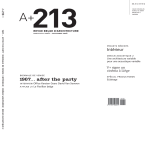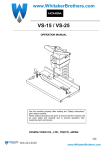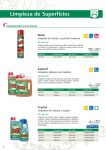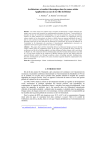Download minimum competence in scientific english extraits
Transcript
EXTRAITS MINIMUM COMPETENCE IN SCIENTIFIC ENGLISH nouvelle édition - pap-ebook Sue BLATTES - Véronique JANS - Jonathan UPJOHN Pool de langues de l’Université Joseph Fourier de Grenoble 17, avenue du Hoggar Parc dÕActivit de CourtabÏuf, BP 112 91944 Les Ulis Cedex A, France Minimum Competence in Scientific English (MCSE) est un pap-ebook Qu’est-ce qu’un pap-ebook® ? Le pap-ebook se compose de deux éléments : le livre papier et un site web en accès libre : • Le livre est l’objet central totalement autonome. Il a bénéficié de toute la démarche d’expertise et, une fois sélectionné, d’une optimisation propres au label de Grenoble Sciences. • Le site web compagnon peut, suivant les cas, proposer : - des prérequis permettant de combler certaines lacunes, - des exercices pour s’entraîner, - des compléments pour approfondir un thème, trouver des liens sur internet, etc. Pour accéder à la liste des pap-ebooks de Grenoble Sciences : http://grenoble-sciences.ujf-grenoble.fr/pap-ebooks/ Le site web en libre accès de MCSE Le site web de MCSE comprend une part notable d’exercices qui renforcent l’action du livre, notamment par des apports audio. Ce site s’enrichit à chaque réédition du livre MCSE et constitue une véritable porte d’entrée sur un environnement d’apprentissage en développement permanent. Pour accéder au site web : http://grenoble-sciences.ujf-grenoble.fr/pap-ebooks/upjohn AVANT-PROPOS MCSE NOUVELLE ÉDITION – Depuis sa première édition en 1991, Minimum Competence in Scientific English a joué un rôle important dans l'enseignement de l'anglais scientifique en France. Plus de 200 000 scientifiques l’ont utilisé et il a semblé opportun de l’améliorer pour mieux répondre à l'attente des nouvelles générations d'étudiants. La structure de base ayant fait ses preuves, nous l'avons gardée comme telle. En revanche, les textes ont été renouvelés et furent affinés les key points et le lexis, élargie la gamme des activités linguistiques et communicatives et intégrée l'utilisation du web. } } } Public visé – MCSE a été conçu d’abord pour les étudiants des universités scientifiques et technologiques, des IUT et des écoles d'ingénieurs ayant une base d'au moins trois années d'anglais, mais il est également adapté à tous les scientifiques francophones. Contenu linguistique – L'ouvrage est fondé sur une analyse du discours scientifique, notamment sur un recensement de la fréquence du lexique scientifique, et des fonctions qui sous-tendent le discours scientifique. C'est cette analyse préalable qui a permis d'établir un contenu particulièrement pertinent. Contenu pédagogique – Pédagogiquement, l’utilisateur se voit doté des armes nécessaires à un apprentissage efficace. D'abord il dispose d’un système d'auto-évaluation combiné avec une check list et peut établir avec clarté ce qu’il doit apprendre. Ensuite l’utilisation répétée des éléments permet d’optimiser l’apprentissage. MCSE regroupe donc pour l'étudiant un inventaire de ce qu'il doit savoir, avec les outils pour l'apprendre. Il permet un parcours d'apprentissage rapide, efficace et, par conséquent, un parcours qui apporte beaucoup de satisfaction. MODE D’EMPLOI – MCSE peut être utilisé de plusieurs façons : dans le cadre d'un cours traditionnel, en semi-autonomie ou en autonomie. Les quelques suggestions qui suivent sont loin d'être exhaustives. L'ouvrage est divisé essentiellement en 2 sections : les 12 units, suivies d’annexes et d’un lexis. Chaque unit correspond à une fonction de base de l'anglais scientifique, measurement, frequency, hypothesis, etc. et comprend : } } Entry test – Ce test permet de faire d'emblée une évaluation réaliste de son niveau ; trop fréquemment, l'apprentissage est entravé par l'ignorance de l'étudiant quant à ses propres lacunes. Key points – Les key points doivent être considérés comme une check list, indiquant tous les éléments qui doivent être sus. Ainsi, et après avoir fait l’entry test, l'étudiant est en situation, dès le départ de l'unit, de déterminer avec précision ce qu’il doit faire, c'est-à-dire son "contrat d'apprentissage". } } } } } Exercises – Ce sont les exercices qui permettent de mettre la langue en pratique, de la manipuler et donc de l'assimiler. Ceux-ci se caractérisent par une répétition et une réutilisation continuelle des fonctions et du vocabulaire, pour qu'en fin de parcours tout étudiant "ne puisse pas ne pas avoir appris". Notons, dans cette nouvelle édition, les starters, dont le but est d'amorcer un travail d'imagination de l'étudiant et de l’impliquer avant d'aborder le texte. Nouveaux également, les talking points, qui ouvrent la voie vers une interaction orale en petit groupe. Les checkpoints constituent une autre innovation conçue pour permettre une révision et un approfondissement de trois domaines cruciaux pour l'apprentissage : In other words – Savoir reformuler est une compétence essentielle pour l'apprenant qui, par définition, a des difficultés à se faire comprendre. Il est donc de première importance qu'il puisse maîtriser les outils lui permettant de clarifier, de reformuler, et de "dire autrement". Back to basics – Trop souvent, hélas, les apprenants, même avancés, traînent d'année en année comme des boulets certaines erreurs de débutant, déjà corrigées 100 fois mais sans résultats. Cet exercice donne à l'étudiant la possibilité de faire le point sur son propre savoir et, ensuite, lui donne les outils pour se débarrasser de ses erreurs. The word web – Un mot n'existe pas seul, mais seulement en relation avec les autres. Cet exercice donne l'occasion de revenir sur les familles lexicales, les homonymes et les synonymes, la formation et la structure et de les approfondir. Nouveaux aussi sont web search et word search. Le premier prolonge le travail sur les textes en exploitant les richesses du web, le second, technique originale, amène l'étudiant à utiliser le web comme corpus pour personnaliser son propre apprentissage. Exit test – Comme dans les éditions précédentes, chaque unit se termine par un exit test où l'étudiant peut faire un constat objectif de ses progrès et en tirer les conclusions. Le lecteur trouvera ensuite des annexes : OHP (utilisation du rétroprojecteur), answers (corrigés des exercices) et grammar notes (notes grammaticales). Enfin, le lexis joue un rôle primordial dans MCSE. A ce stade, et contrairement à ce que tant de personnes pensent, ce n'est pas la structure mais bien le lexique qui est le maillon faible des apprenants. Cette liste de vocabulaire de haute fréquence, organisée en rubriques, est construite à partir d'un pré-acquis du vocabulaire de base de quelques 1 200 mots et des homographes communs à l'anglais et au français. Elle constitue un outil puissant, permettant à un étudiant de "couvrir" 85% des mots de tout texte dans sa spécialité. MCSE s'adresse à des apprenants volontaristes et motivés qui ont fait le choix de passer au stade d’utilisateur professionnel. Il permet à celui qui s'investit et qui travaille de façon intelligente d'atteindre, après une année ou dix-huit mois, un niveau de langue où il pourra utiliser indifféremment des documents en anglais ou dans sa langue maternelle, où il pourra parler de sa spécialité, sinon dans un anglais parfait, du moins avec clarté et aisance. TABLE OF CONTENTS CHECKPOINTS WEB In other words "to be" Back to basics Questions The word web Suffixes: ment - th - ness - en - Ø Image search – OHP presentation Fetal development – week 30 Test writing In other words "which / that" Back to basics "actually" The word web Multi-word verbs Space travel – physiological effects Babbage Contextual search – "actually" In other words "similar to … but + comparative" Back to basics "to agree" The word web Suffixes: verbs and nouns ation - sion - ise In other words "that is to say" Back to basics "important" The word web Adjectives + prepositions Comparative data – OHP presentation FAQs – airships Test writing (Units 1- 3) In other words "consists of" Back to basics "according to" The word web Negative prefixes: anti - dis - im - in - ir- un In other words "basically … in other words" Back to basics "turn into" The word web Adjective suffixes: able- al- ful- ic- ine- ish- ive- less In other words "someone whose job is to …" Back to basics "raise / rise – lay / lie" The word web Verb prefixes: over- under- un Black holes Griffon vultures Contextual search – link words In other words "if … then" Back to basics "hard / hardly" The word web Verbs meaning "to perform" Conditionals – OHP presentation NEO – FAQs Contrastive search – "hard / hardly" In other words "either … or" Back to basics Uncountable nouns: "adviceinformation-news-equipment" The word web Multi-word verbs In other words "designed to transform into" Back to basics "grow / grow up - experience / experiment - last / latest realise / carry out" The word web Suffixes: able- acy- ence- hoodic- ing- ity- ive- ment- tion The Nice tsunami Alternative energies Past modals SEARCH – WORD SEARCH FAQs on cholera Causes of mortality Contextual search – "important" Dangerous sports – OHP presentation Hubble – the latest news Contextual search – present perfect The geography of lightning Treating AMD Test writing (Units 5-7) Aviation crashes – report Process description – OHP presentation Search strings – "make it impossible" 8 MINIMUM FUNCTIONS & GRAMMAR UNIT 11 P. 127 Impersonal forms Entry test Exit test UNIT 12 P. 137 Compound nouns & adjectives Entry test COMPETENCE IN SCIENTIFIC ENGLISH EXERCISES Bridge building Exercise "e-noses" and tuberculosis Looking after mummy Life sciences laboratory equipment (LSLE) Exercise Landmines – the Dervish Intracytoplasmic sperm injection Exit test ANNEXES Using the OHP and graph description P. 149 Answers: • Units 1-12 • OHP P. P. 161 178 Grammar notes P. 179 2. FREQUENCY Frequency is the expression of repetition. It refers to events that occur more often than once and less often than always. Frequency is, of course, related to measurement and consequently you will meet certain expressions already seen in Unit 1 for a second time. This function can be expressed by: – lexical items (particularly adverbs), – grammatical structures (particularly word formation), – certain fixed adverbial phrases. Self evaluation – entry test Fill in the blanks using appropriate expressions. The first two letters of the answer are printed. Example: The batteries must be recharged tw ....................... a month. (two times) ➙ The batteries must be recharged twice a month. 1. Under stress, the heart be .......…......…... faster. (pulsates) 2. Over the past 100,000 years, the polar ice sheets have advanced or retreated depending on periodic sw …………….... in the climate. (variations, oscillations) 3. The famous 19th century millionaire, Carnegie, emigrated to the US from Scotland and began work in a factory for $1.20 pe .........…...... week. (each) 4. There will be a re .....…......…..... of epidemics as soon as natural immunisation dies out. (they will happen again, repeated incidence) 5. The Ebola virus produces a mortality ra ....…..….. which can be as high as 88% in human beings. (a measure of frequency) 6. Over the past 300 years, the average height of Europeans has increased st .........…........... . (regularly) 7. The world population is growing fast. A new child is born ev …………..………. 60 seconds. (each minute) 8. The se ............... of earthquakes that struck Missouri in 1811 were among the most powerful ever experienced in the United States. (succession, repeated incidents) 9. It is estimated that the ho .……...…......... flow of water of the Amazon river is between 12,000 and 44,000 million litres. (every 60 minutes) 10. The strength of a steel alloy depends on the ra …………..… of iron to carbon. (mathematical relationship of proportion) 70 MINIMUM COMPETENCE IN SCIENTIFIC ENGLISH Functions & Grammar KEY POINTS – ORGANISING TIME: THE PRESENT & THE PAST ➙ There are four present tenses and four past tenses. PRESENT TIME 1. Present simple Example Meaning The newspaper says ... He likes Ann. She drinks coffee. She lives in Turin. He leaves for work at 7 o'clock. Water freezes at 0°C. The "general" present. Opinions and habits. The "status quo". Habitual actions. Scientific facts. TYPICAL TIME MARKERS (N.B. – Time markers may be implicit) every day usually often sometimes 2. Present continuous Example Meaning Look! It is raining. Mary is trying to finish her work. At the moment, he is working in London. On-going present time. Actions happening now. Temporary actions in the present. TIME MARKERS now at the moment currently at present temporarily 3. Present perfect simple Example Meaning She has already finished her work. He has broken his leg. It is important now / a surprise. The result is important – he can't walk now. UNIT 7 – CAUSE & 83 CONSEQUENCE 3. Nouns Cause cause reason origin source The real cause of his resignation was bad health. Consequence • consequence result outcome effect • by-product spin-off The final outcome of the illness was the minister's resignation. starter Examples in context THE SCANNING ELECTRON MICROSCOPE (SEM) Read the description and find synonyms for the words in bold. • Ask your neighbour questions about scanning electron microscopes. How? – what for? – who? – when? As the wavelength of visible light is approximately 4,000 angstrom, this means that there is a lower limit to the resolution of optical microscopes. To obtain higher resolution, shorter wavelengths are required. Electrons used in SEMs have wavelengths of 0.5 angstrom, hence it is possible to visualise molecules and even atoms. Samples cannot be scanned unless they are dry (to prevent vaporisation) and electrically conductive. As a result, organic materials must be coated with a metallic layer, such as gold. Thanks to the scanning pattern, a 3-dimensional image of the surface structure can be obtained. The suggestion that electrons might be regarded as a form of wave motion and used for microscopy stems from the work of Louis de Broglie (1924), as an outcome of his research into quantum mechanics. The first SEM was built in 1933. Dust mite (Acari) 130 MINIMUM COMPETENCE IN SCIENTIFIC ENGLISH Exercises 11.1. Exercise A. "All generalisations are dangerous, even this one", said Alexandre Dumas fils. We can make them more acceptable by qualifying them. Match the phrases. 1. 2. 3. 4. 5. 6. It is hardly ever acknowledged that … It is sometimes claimed that … It is commonly thought that … It is seldom admitted that … It is widely believed that … It has often been suggested that … a. the rich are too rich and the poor are too poor. b. efficient government is impossible in a democratic society. c. after the age of 55, the accident rate of surgeons increases sharply. d. the stars influence our health. e. incest is not uncommon in Western Europe. f. university examination procedures are unreliable. g. simple people are more honest than intellectuals. B. Make qualified generalisations about the photos. Dolphins Dolphins Women Apples Americans C. Make two qualified generalisations of your own. Scientists 120 MINIMUM 10.2. Sleeping pilots and chaos theory Why are there accidents? Where does the responsibility lie? One of the uses of technology is to devise ways and means of reducing the consequences of human error. Fill in the gaps with the following words: SO THAT ENABLES OBJECTIVES DESIGN MAKES IT POSSIBLE TO BY MEANS OF DEVISE PROVIDE IS RESPONSIBLE FOR COMPETENCE IN SCIENTIFIC ENGLISH starter • Give examples of both major and minor accidents. • Were they brought about by faulty technology or human error? • Was any action taken as a result of the accident? • Give examples of how technology can be used to increase safety. Despite the thousands of parts which are used in the construction of aeroplanes, very few air-crashes are caused by component failure. It is, in fact, human error that .……………….….…………….… 80% of air accidents. This explains why one of the primary ..…………….…. of the aircraft industry today is to …….…………….……… ways of improving these figures. One area of particular concern is pilot fatigue. This problem is far more widespread than is commonly realised and Dr. Mark Rosekind claims that "70% or more pilots say that they have fallen asleep at least once while piloting". Fatigue is particularly linked to the crossing of time zones which can severely disturb the circadian rhythm. The Japanese company, Electronic Navigation Research Institute (ENRI), is currently in the process of developing a monitoring system which will be able to .………………… early warning of fatigue .………….……………. voice recognition techniques. Normal voice pattern Fatigued voice pattern Biological functions, such as blood pressure, heartbeat and voice, have a fractal structure which can be identified. Under stress or fatigue, these physiological manifestations undergo change and consequently, as can be seen in the figure, the pattern alters, gradually losing its structure and becoming chaotic. By using the mathematics of chaos theory, Kakuichi Shiomi, chief researcher of ENRI, has been able to .………… software which .…………… these minute distinctions to be identified .…………… the pilot's voice pattern can be matched with a control model of an alert voice. It takes no more than 10 seconds for data samples to be processed which means that fatigue can be measured in real time without interfering with the normal activity of the flight crew. According to Shiomi, the system …….……………………….……… detect tiredness in test subjects 10 to 20 minutes before they become aware of it themselves. UNIT 2 – FREQUENCY 33 2.4. Checkpoints IN OTHER WORDS Definitions – relative clauses: "which / that" Make a definition using the pattern: "An X is a Y which does Z." Example: "A bat is a mammal which flies by night." Define these words used in Exercise 2.2: predator sonar system skin food BACK TO BASICS "Actually": do you use this word correctly? Is the following sentence correct or not? "Actually, the number of illiterate people in the world is increasing steadily." Check in the answer section. THE WORD WEB – MULTI-WORD VERBS The meaning of many verbs depends on the preposition or adverb that follows. These are called multi-word (or phrasal) verbs. Match the meaning of the verb with the definition and then write in the correct particle for each verb: IN OF UP OUT FOR ON. 1. When visibility is reduced, airports rely …….. radar control. 2. In 1830, Babbage designed a machine to carry ……. complex arithmetical calculations. 3. A protein may consist ……. several polypeptide chains held together by weak molecular bonds. 4. In 1937, four Soviet scientists set ……. temporary scientific stations on drifting icebergs in the Arctic. 5. Chemists can work ……. the number of carbon atoms from the weight of the object. 6. Testosterone is involved ……. the development of secondary sex characteristics such as the growth of body hair, and changes in the larynx. 7. It is the ability to use the Sun and the stars to navigate which accounts ……. the migration of birds. 8. The level of pH depends ……… the strength of the acid. a. to do / to perform b. to be made of / formed from c. to be determined by d. to calculate / find the solution e. to create / establish f. to use because you have confidence g. to be linked / a necessary part of h. to provide an explanation USING THE 153 OVERHEAD PROJECTOR FRAMING Good morning. Well, what I would like to discuss with you today is the problem of rising medical expenses, and with particular with reference to the situation in France. TOPIC & FOCUSING RELEVANCE OF TOPIC As you know, over the last 40-50 years, there has been a steep increase in medical expenditure and governments are now faced with a major political problem of finding ways of financing the health services. ORGANISATION & SEQUENCING To begin with, we will look at a line graph, giving comparative data for male and female expenditure during a normal life span. This will be followed by a short commentary and finally, I will go on to discuss some of the causes and consequences of this state of affairs. The line graph in the figure is adapted from INSEE 1999 and gives comparative data for the average annual per capita expenses for men and women in France. As can be seen, age is indicated at 10 years intervals on the horizontal axis, while annual costs are shown in euros on the vertical axis on the left hand side – here. GENERALISATION COMPARISON REFORMULATION LINK WORD SOURCE REFERENCE TO VISUALS & APPROXIMATION Basically, what the graph shows is that, in the first few years of life, there is a tendency for medical costs to be similar for the two sexes. That is to say, the younger people are the more medical care they need so, as can be expected, immediately after birth spending is high (roughly 200 euros). DETAILED DATA DESCRIPTION However, over the next 5 years, the curve drops steeply for both sexes and then levels off until the age of 10. CHRONOLOGY MODIFICATION At this stage the two curves separate. The bottom curve – here – for males, continues to drop until the age of 20, where it reaches its lowest point of approximately 80 euros. From then on, it rises slowly but steadily in function of age, with a slight acceleration after the age of 55. 174 • • • • • MINIMUM to take out a tooth – remove to step up production – increase to step in to prevent a conflict – intervene to cut up meat – divide into small pieces to cut off the electricity – stop the supply 7. 8. 9. COMPETENCE IN SCIENTIFIC ENGLISH In what way is the pressure transmitted? What do the valves control? What was responsible for industrial stagnation? Exercises Exit test 1. 2. 3. 4. 5. 6. 7. 8. 9. 10. might / may (have) should must have could / can may / could / might have will assume feasible expected likely ➜ 1. 2. 3. 4. 5. 6. 7. 8. 10.1. – A designed provides responsible for make it possible in order to so that purpose aims ➜ 10.1. – B 1. / f 2. / a 3. / b 4. / e 5. / g 6. / d 7. / c ➜ UNIT 10 Entry test 1. 2. 3. 4. 5. 6. 7. 8. 9. 10. target supplying so as to aim thereby designed / devised by means of enables allowed through Examples in context 1. 2. 3. 4. 5. 6. What does the human being provide? How does the machine operate? How does the man keep his balance? What do the counterweights do? What is the water pipe for? What do the steel springs do? 10.2. • … human factor that is responsible for 80% of air accidents… • … the primary objectives of the aircraft industry … • … is to devise / design ways of improving these figures… • … will be able to provide early warning … • … by means of voice recognition … • … has been able to design / devise software … • … which enables these minute … • … be identified so that the pilot’s voice … • … the system makes it possible to detect tiredness … ➜ • • • • • • • 10.3. What has it enabled them to do? What was the primary aim? Why do they adopt unusual behaviour? Why did she shift position? What was the objective? What made it impossible to gain access? What were the counter measures devised to do? • Why did he walk away? M INIMUM 198 /t S e k / Check 1.v n 2.v Note — To check is often followed by a particle which changes its meaning. ➛ to check in at the airport (to register) ➛ to check out of a hotel (to leave, to pay the bill) ➛ to check over someone's work (to reread, to verify) ➛ to check up on some calculations (to verify) Cost n /k Å s t / Mass production reduces costs . The cost of living . The cost of recycling industrial waste is increasing. (cost, cost, cost) The car costs a lot of money. Developing alternative fuels will cost millions of dollars. ➙ What must be paid, the price. To require money v Couple 1.n 2.v /» k √ p l / To have a couple of drinks. She noticed a couple of mistakes. ➙ Two together To couple two circuits together. Economic growth is closely coupled to capital investment. ➙ To join, to link Cross-section n n /k r Å s » s e k S n / To examine the cross-section of a sample under a microscope. The resistance of wire is proportional to its length and its cross-section. A cross-section of society. ➙ A view of an interior surface. A typical sample Data /d i ˘ p / Deep To check the oil level of a car. The results must be checked before publishing them. Workers exposed to radiation must have a monthly check-up. ➙ To verify, inspect. Inspection New vaccines will check the spread of the disease. ➙ To stop temporarily, to slow down adj adv n Note — Data is a Latin word: Sing. "datum" . Pl. "data" . "Datum" is rarely used. "Data" can be either singular or plural. ➛ the data is … / the data are … Avalanches are most common when the snow is deep. The notion of male superiority is deeply rooted in traditional societies. What is the depth of the river? ➙ Profound. Distance below the surface Draw /drç˘/ (draw, drew, drawn) 1.v n 2.v To draw a straight line. Under hypnosis, adults appear to draw like children. To study a technical drawing. ➙ To mark on paper, to make a picture. Graphic representation The air is drawn into the lungs via the nose. It is too early for a conclusion to be drawn . ➙ To move in a direction. To arrive at Even /»i˘vn/ 1.adj The microscope must stand on an even surface . The temperature must remain even throughout the experiment. adv The population is evenly distributed. ➙ Smooth, regular. Equally 2.adj 4, 6, 8, are even numbers. ➙ Divisible by 2 π odd 3.adv Even the doctor was ill. Even if you take a taxi, you will still be late. ➙ Surprisingly, believe it or not Extend v /Ik»stend / The region extends from Hungary to Poland. The electromagnetic spectrum extends to ultraviolet and to X-rays. ➙ To cover a distance, to reach, to include Extent /I k » s t e n t / n To what extent does meteorology effect human behaviour? To a certain extent, disease depends on the standard of living. ➙ Degree, amount Far /f A ˘ / 1.adv How far is it to the post office? So far, no one has been able to find an answer. As far as I am concerned , the matter is of no importance. ➙ Distant. Up to now. To that extent It is far too hot to work. Working conditions are now far better. ➙ Much, considerably He lives on the far side of the town. The Far East. ➙ Distant, remote π near /d e I t ´ / The data is stored on the hard disk. To study data-processing . With a binary system, data can be handled much more quickly. ➙ Information, facts COMPETENCE IN SCIENTIFIC ENGLISH 2.adv 3.adj























